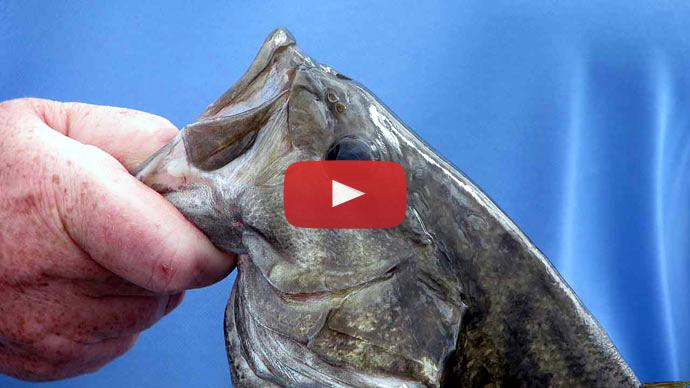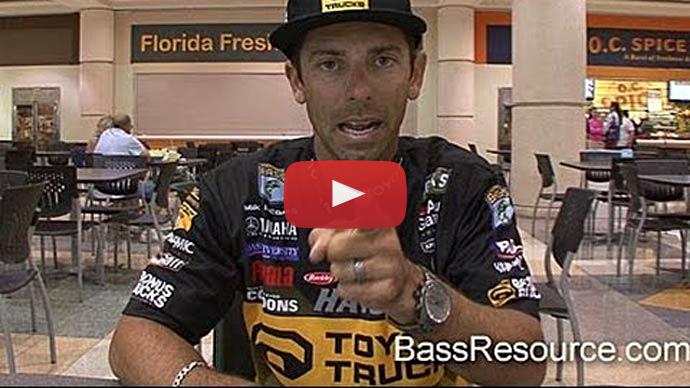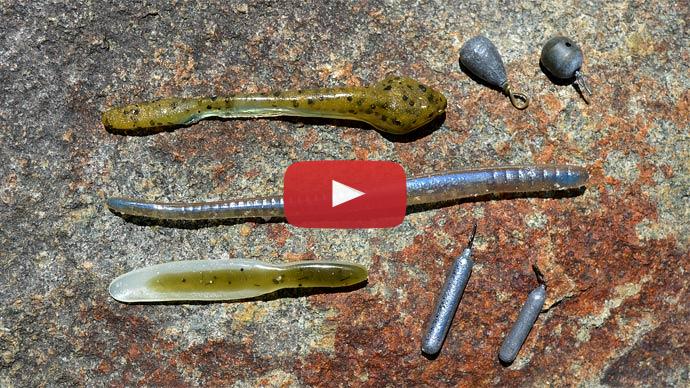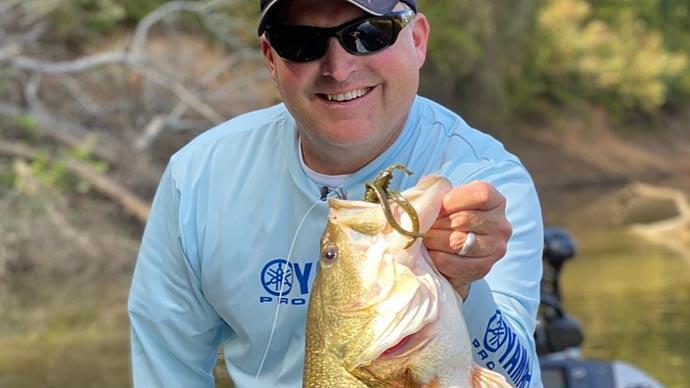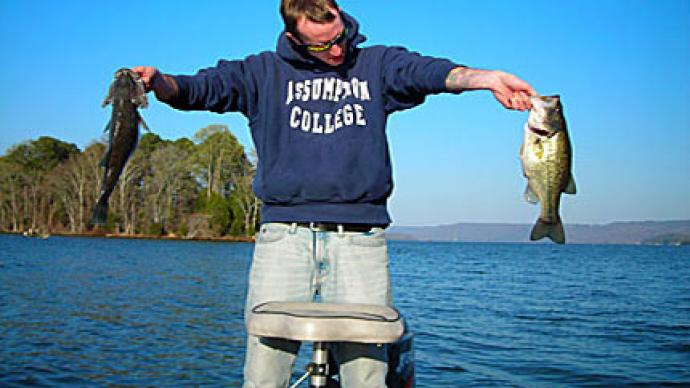Hey, folks, Glenn May here with BassResource.com. Today, I want to talk to you about fishing a drop shot rig. Now, if you're not sure how to rig a drop shot, it's pretty straightforward. I have some videos on how to do that. But we just have a drop shot sinker here. It's tied on loosely. This is a eighth-ounce. And that's a good starting weight for this, an eighth-ounce. You typically don't need much heavier than that. But if you're fishing really deep, if you're fishing current, or if you're fishing in windy situations, then you might want to go up a little bit to maybe a three-ounce or even a quarter-ounce weight. But an eighth-ounce is pretty much your bread and butter. That's what you're going to use most the time.
I've got it 18 inches up. Then I've got my Spinshot . . . look at how that spins, Spinshot hook. I love these things because it cuts down on line twist and allows the bait to move freely. And then I'm just using a four-inch finesse worm here, just nose hooked, perfect bait for this type of setup.
Now, you notice I got an 18-inch leader on here. This is what you want to do in the summertime or when you fish in really clear water. You want at least an 18-inch leader. Sometimes I go 24-inch. The fish are a little more active. You can get this a little bit further off the bottom. They're going to see it from further distances. And they'll come up and hit it.
In the winter time, you pretty much have to get it right in front of them when they're hugging the bottom. So you can bring it down to about 10 inches, maybe 12 inches, but nothing shorter than that. And one of the reasons why is you're casting it out there, and you're reeling it back. It's not straight up and down like this. It's at an angle. So even though you've got 18 inches here, you're not 18 inches off the bottom. You're more about 12 inches or so with this kind of setup. If you've got your bait this close to the weight, like a lot of people . . . I've seen a lot of people do it this way. Well, when you're dragging it back, now you're only what? Two inches off the bottom if that. It defeats the purpose of a drop shot. So I don't go anything shorter than eight inches. In this case, I'm doing 18 inches, warmer months.
I'm tied to it. I'm using a six-pound. I'm not using straight fluorocarbon. I know some people really like to use fluorocarbon for the sensitivity. And there's nothing wrong with that. You can certainly use that. I'm not saying that that's wrong at all. Just for me, I've been doing this for 30 some odd decades and kind of hard to teach an old horse new tricks. So I like to just use that blended fluorocarbon, copolymer mix. Works great for this six-pound test, real light. And that's why we’re using this real light wire hook. You don't need anything heavier than that.
And because of that, I'm using a rod here that's a medium light action rod. Anything heavier than that, you may end up breaking a line or straightening out that hook. So a medium light action rod is a perfect match to this setup. This is a spinning outfit, perfect for what we're going to do.
All right, so that's the gear you're going to use. Now, let's go out and fish it.
All right, so what I'm fishing here is an area that's got a rocky bottom to it, with a little bit of weeds. It's a great place to fish the drop shot rig. Now, all that you're going to do when you cast it out there, don't throw it really hard because you might throw the bait of the hook, because it's just nose hooked, remember. Just a nice easy lob cast, and you'll get it out there quite aways. You can also do just an underhand cast, kind of like a pitch. That works really well too.
But cast it out there and watch the line when it hits the water. And just flip the bail over and watch that line where it hits the water, because you want to see if it . . . Sometimes, the fish hit it when it's falling. So you want to see if it jumps, twitches, pops. I'm watching it. I'm watching it to see if anything happens. Okay, now, it's on the bottom.
Once it hits the bottom, all that you're going to do is reel up to it, and you're going to want to hold it steady. Just try to hold the bait in place.
Now, you don't want to move it at all. And it's funny, you might think that you're not moving the bait. Matter of fact, I'm going to reel this down. I want the rod down, so I'm ready to set the hook. But just hold that in place. You don't want to move it at all. And I'm reeling because the boat's moving.
And so subtle movements, that's what's moving this bait around. Think about it. If you take your hand and hold it real steady in front of you, hold it as still as you possibly can for like 30 seconds, and you'll notice, there's movement. It's always going to be moving. No one can hold it completely still.
Well, that's movement's going to resonate down the rod, down the line into your bait. Think about it even further. There's always current in any body of water. Even on a lake, the water is not stagnant. It's always moving, whether it's wind-driven current or weight-driven current, something like that. And even the breeze on the water, you're going to get these little ripples on the water. It's hitting the line. And that is going to transmit down the line. So the bait is always moving, even if you're holding it perfectly still. And a lot of times, that's when the fish will hit it.
Now, once you can't stand it anymore, now what you want to do is just give it a little shake. You can see, I'm just moving the rod tip, and that's it. Not moving the weight, you want to shake the bait, not the weight. Okay, just think about that. Shake the bait, not the weight. And just give it a little pop. And that's it.
Now, to move it . . . Okay, I moved up on it because the wind pushed the boat into that. So let me show you how I move it.
All that you're going to do is lift it up and let it drop, and then do it all over again. You're not going to lift it up much. Just move it a little bit. And this is a real slow methodical way of covering water. This is not a technique you're going to use to find fish. This is what you use once you've located an area where they're at. And you want to pick apart a place and pick up all the fish in that area. This works great if you’ve covered an area with fast-moving bait, like a spinner bait or a crank bait or top water. Then you back through it methodically with this.
So you just lift it up, let it drop. And then you're going to shake it. And it's just a little bit of movement with the rod tip. Let it sit. You can shake it a little bit more. Let it sit till you can't stand it anymore. Then lift it back up. Move it a couple feet, maybe a foot or two. Let it drop. And, again, just hold steady and just do that again. Just wait and wait and wait and wait and wait. Give it a little shake. You just want to move that rod tip. That's it. It's very, very, very subtle. We're not doing a whole lot of movement here.
And I can sit there and bore you to death with this entire retrieve. It's going to take a long time to get it back. But that's how you fish this bait. It's real slow and methodical.
Once you feel that bite, the hookset, you're not going to reef on it. Don't lay back and hit it really hard. Again, you got an exposed hook. So, really, just bring it. And that's it. It's not a hard hookset. It doesn't take much for that light wire hook to penetrate past the barb. Reel down on it and just pull, and it's set. Matter of fact, if you set it really hard, then you're apt to break the line or to straighten out that hook. So don't hit it really hard.
Anyway, that's basically how you do it. It's very simple, very straightforward, and very effective. If you do it using the technique I just showed you, you're going to have a whole heck of a lot of fun.
For more tips and tricks like this, visit BassResource.com.

